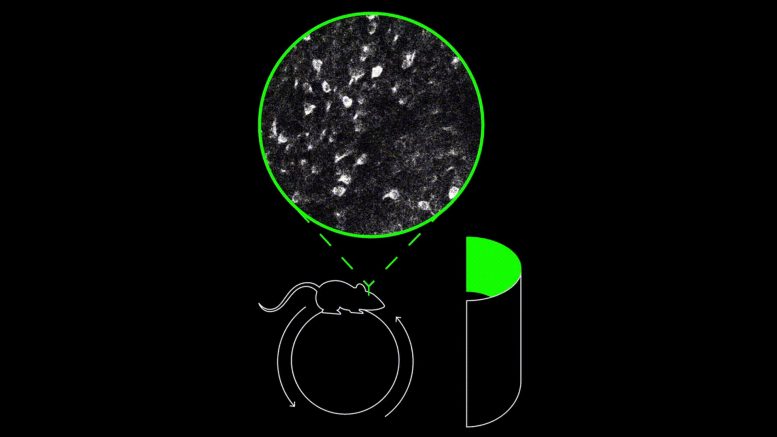Researchers at the University of Utah Health found that “time cells” in mice adapt to learning timed tasks, a discovery that could aid early Alzheimer’s detection by monitoring changes in a key brain region.
Our perception of time is crucial to our interaction with and understanding of the world around us. Whether we’re engaging in a conversation or driving a car, we need to remember and gauge the duration of events—a complex but largely unconscious calculation running constantly beneath the surface of our thoughts.
Now, researchers at the University of Utah Health have found that, in mice, a specific population of “time cells” is essential for learning complex behaviors where timing is critical. Like the second hand of a clock, time cells fire in sequence to map out short periods of time.
But time cells aren’t just a simple clock, the researchers found—as animals learn to distinguish between differently timed events, the pattern of time cell activity changes to represent each pattern of events differently. The discovery could ultimately aid in the early detection of neurodegenerative diseases, such as Alzheimer’s, that affect the sense of time.
The new study is published in Nature Neuroscience.
Mouse code
By combining a complex time-based learning task with advanced brain imaging, researchers were able to watch patterns of time cell activity become more complex as the mice learned. The researchers first set up a trial where learning the differences in the timing of events was critical. To get a reward, mice had to learn to distinguish between patterns of an odor stimulus that had variable timing, as if they were learning a very simple form of Morse code.
Left to right: James Heys, PhD; Erin Bigus; Hyunwoo Lee, PhD. Credit: Left to right: Charlie Ehlert, Matthieu Couriol, Kyung Jennifer Lee.
Before and after the mice learned, the researchers used cutting-edge microscopy to watch individual time cells fire in real-time. At first, their time cells responded in the same way to every pattern of odor stimulus. But as they learned the differently timed patterns of stimulus, the mice developed different patterns of time cell activity for each pattern of events.
Notably, during trials that the mice got wrong, the researchers could see that their time cells had often fired in the wrong order, suggesting that the right sequence of time cell activity is critical for performing time-based tasks. “Time cells are supposed to be active at specific moments during the trial,” said Hyunwoo Lee, PhD, a postdoctoral fellow in neurobiology in the Spencer Fox Eccles School of Medicine at the University of Utah and co-first author on the study. “But when the mice made mistakes, that selective activity became messy.”
Not just a stopwatch
Surprisingly, time cells play a more complicated role than merely tracking time, said Erin Bigus, graduate research assistant in neurobiology and co-first author on the study. When the researchers temporarily blocked the activity of the brain region that contains time cells, the medial entorhinal cortex (MEC), mice could still perceive and even anticipate the timing of events. But they couldn’t learn complex time-related tasks from scratch. “The MEC isn’t acting like a really simple stopwatch that’s necessary to track time in any simple circumstance,” Bigus said. “Its role seems to be in actually learning these more complex temporal relationships.”
The researchers used advanced brain imaging to watch neurons fire before and after mice learned. Credit: Heys Lab / University of Utah Health
Intriguingly, prior research on the MEC found that it’s also involved in learning spatial information and building “mental maps.” In the new study, researchers noticed that the patterns of brain activity that occur while learning time-based tasks show some similarities to previously observed patterns involved in spatial learning; aspects of both patterns persist even while an animal isn’t actively learning.
While more research is needed, these results suggest that the brain could process space and time in fundamentally similar ways, according to the researchers. “We believe that the entorhinal cortex might serve a dual purpose, acting both as an odometer to track distance and as a clock to track elapsed time,” said James Heys, PhD, assistant professor in neurobiology and the senior author on the study.
“These are the first areas of the brain to be affected by neurodegenerative diseases like Alzheimer’s. We are interested in exploring whether complex timing behavior tasks could be a useful way to detect the early onset of Alzheimer’s disease.” – James Heys
Learning how the brain processes time could ultimately aid in the detection of neurodegenerative diseases such as Alzheimer’s, the researchers say. The MEC is one of the first areas of the brain that Alzheimer’s affects, hinting that complex timing tasks could potentially be a way to catch the disease early.
Reference: “Medial entorhinal cortex mediates learning of context-dependent interval timing behavior” by Erin R. Bigus, Hyun-Woo Lee, John C. Bowler, Jiani Shi and James G. Heys, 14 June 2024, Nature Neuroscience.
DOI: 10.1038/s41593-024-01683-7
The study was funded by the U.S. National Science Foundation, the Whitehall Foundation, the Brain and Behavior Research Foundation, the National Institute of Mental Health, the National Research Foundation of Korea, and the University of Utah.
News
Most Plastic in the Ocean Is Invisible—And Deadly
Nanoplastics—particles smaller than a human hair—can pass through cell walls and enter the food web. New research suggest 27 million metric tons of nanoplastics are spread across just the top layer of the North [...]
Repurposed drugs could calm the immune system’s response to nanomedicine
An international study led by researchers at the University of Colorado Anschutz Medical Campus has identified a promising strategy to enhance the safety of nanomedicines, advanced therapies often used in cancer and vaccine treatments, [...]
Nano-Enhanced Hydrogel Strategies for Cartilage Repair
A recent article in Engineering describes the development of a protein-based nanocomposite hydrogel designed to deliver two therapeutic agents—dexamethasone (Dex) and kartogenin (KGN)—to support cartilage repair. The hydrogel is engineered to modulate immune responses and promote [...]
New Cancer Drug Blocks Tumors Without Debilitating Side Effects
A new drug targets RAS-PI3Kα pathways without harmful side effects. It was developed using high-performance computing and AI. A new cancer drug candidate, developed through a collaboration between Lawrence Livermore National Laboratory (LLNL), BridgeBio Oncology [...]
Scientists Are Pretty Close to Replicating the First Thing That Ever Lived
For 400 million years, a leading hypothesis claims, Earth was an “RNA World,” meaning that life must’ve first replicated from RNA before the arrival of proteins and DNA. Unfortunately, scientists have failed to find [...]
Why ‘Peniaphobia’ Is Exploding Among Young People (And Why We Should Be Concerned)
An insidious illness is taking hold among a growing proportion of young people. Little known to the general public, peniaphobia—the fear of becoming poor—is gaining ground among teens and young adults. Discover the causes [...]
Team finds flawed data in recent study relevant to coronavirus antiviral development
The COVID pandemic illustrated how urgently we need antiviral medications capable of treating coronavirus infections. To aid this effort, researchers quickly homed in on part of SARS-CoV-2's molecular structure known as the NiRAN domain—an [...]
Drug-Coated Neural Implants Reduce Immune Rejection
Summary: A new study shows that coating neural prosthetic implants with the anti-inflammatory drug dexamethasone helps reduce the body’s immune response and scar tissue formation. This strategy enhances the long-term performance and stability of electrodes [...]
Scientists discover cancer-fighting bacteria that ‘soak up’ forever chemicals in the body
A family of healthy bacteria may help 'soak up' toxic forever chemicals in the body, warding off their cancerous effects. Forever chemicals, also known as PFAS (per- and polyfluoroalkyl substances), are toxic chemicals that [...]
Johns Hopkins Researchers Uncover a New Way To Kill Cancer Cells
A new study reveals that blocking ribosomal RNA production rewires cancer cell behavior and could help treat genetically unstable tumors. Researchers at the Johns Hopkins Kimmel Cancer Center and the Department of Radiation Oncology and Molecular [...]
AI matches doctors in mapping lung tumors for radiation therapy
In radiation therapy, precision can save lives. Oncologists must carefully map the size and location of a tumor before delivering high-dose radiation to destroy cancer cells while sparing healthy tissue. But this process, called [...]
Scientists Finally “See” Key Protein That Controls Inflammation
Researchers used advanced microscopy to uncover important protein structures. For the first time, two important protein structures in the human body are being visualized, thanks in part to cutting-edge technology at the University of [...]
AI tool detects 9 types of dementia from a single brain scan
Mayo Clinic researchers have developed a new artificial intelligence (AI) tool that helps clinicians identify brain activity patterns linked to nine types of dementia, including Alzheimer's disease, using a single, widely available scan—a transformative [...]
Is plastic packaging putting more than just food on your plate?
New research reveals that common food packaging and utensils can shed microscopic plastics into our food, prompting urgent calls for stricter testing and updated regulations to protect public health. Beyond microplastics: The analysis intentionally [...]
Aging Spreads Through the Bloodstream
Summary: New research reveals that aging isn’t just a local cellular process—it can spread throughout the body via the bloodstream. A redox-sensitive protein called ReHMGB1, secreted by senescent cells, was found to trigger aging features [...]
AI and nanomedicine find rare biomarkers for prostrate cancer and atherosclerosis
Imagine a stadium packed with 75,000 fans, all wearing green and white jerseys—except one person in a solid green shirt. Finding that person would be tough. That's how hard it is for scientists to [...]























